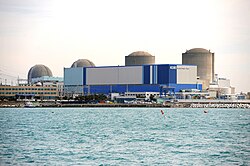
South Korea is a major energy importer, importing nearly all of its oil needs and ranking as the second-largest importer of liquefied natural gas in the world. Electricity generation in the country mainly comes from conventional thermal power, which accounts for more than two thirds of production, and from nuclear power. [1]
Contents
- History
- Overview
- Electric power
- History 2
- Statistics
- Sources
- Thermal
- Cogeneration and steam-heating
- Nuclear Power
- Renewable energy
- Storage
- Global warming
- See also
- References
Energy producers were dominated by government enterprises, although privately operated coal mines and oil refineries also existed. The National Assembly enacted a broad electricity sector restructuring program in 2000, but the restructuring process was halted amid political controversy in 2004 and remains a topic of intense political debate. [2]
South Korea has no proven oil reserves. [1] Exploration until the 1980s in the Yellow Sea and on the continental shelf between Korea and Japan did not find any offshore oil. The Donghae-1 gas field produced natural gas between 2004 and 2021, and natural gas exploration off the east coast was started in 2024. [3]
Coal supply in the country is insufficient and of low quality. The potential for hydroelectric power is limited because of high seasonal variations in the weather and the concentration of most of the rainfall in the summer. As of 2017, South Korean President Moon Jae-in has vowed to end the country’s reliance on coal and also said the nation would move away from nuclear energy. He has taken a major step in that direction in June, saying his country would not try to extend the life of its nuclear plants, would close existing coal-fired plants, and would not build any new coal plants. [4]
In recent years, South Korea has set a new direction for its energy sector, with significant decarbonization goals, aiming to raise the share of electricity from renewable sources from 6% in 2019 to 35% by 2030. [5] [6]





